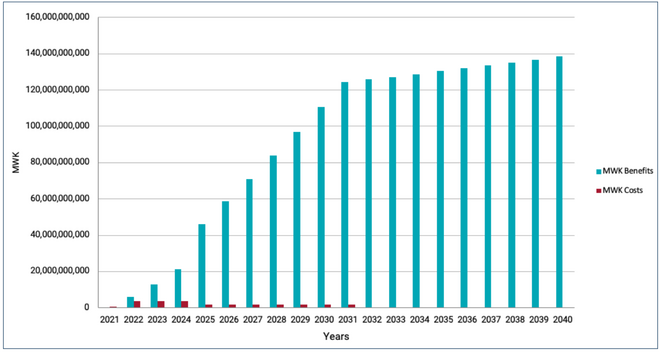Malawi Priorities: Utilities
Technical Report
Key Messages
- Blackouts, shortages, and unreliable access to electricity are a challenge for Malawi’s businesses. Malawian firms experience approximately 7.4 outages per month, with each outage lasting 3.6 hours. Around half of Malawian firms supplement their energy with costly diesel generators. The rest opt into low-productive enterprises that do not require stable electricity or suffer large revenue losses. The coping cost for businesses is estimated at MWK 1557 ($2.09) per kilowatt-hour of unsupplied grid electricity.
- An independent evaluation of ESCOM revealed it showed an insufficient (and in some areas, deficient) corporate governance and management practices as principal causes of its weakened financial position and frequent power outages. The evaluation results, plus evidence from around the world of the impacts of turnaround efforts in electricity and other utilities, motivate a technical assistance program.
- We recommend that the ESCOM board consider providing a 10-year long-term technical assistance program to improve corporate governance and management practices at ESCOM. This is expected to address some, but not all, the challenges of electricity provision, effectively preventing 5% of Malawi’s generated electricity from being lost before it reaches the consumer. In 2030 this would increase business and household income by a combined MWK 110 billion, equivalent to 1% of projected GDP through avoided generator costs, increased business productivity, and avoided costs of torches and candles. From 2022 until 2040, the intervention is expected to generate a staggering MWK 1.9 trillion in economic benefits. Every MWK 1 invested in this program, Malawi will reap MWK 41 in benefits, an excellent return on investment that will provide a substantial contribution to Malawi’s economic growth aspirations.
- Technical assistance programs are more likely to succeed if they are contextually appropriate. Therefore, the intervention includes an initial design phase to ensure strategies are relevant to Malawi’s electricity sector. Better management could improve operations in areas such as grid maintenance, development of better adaptation strategies to mitigate demand surges, and ensuring procurement calendars are up-to-date and adhered to.
- The 10-year long-term technical assistance program is expected to cost MWK 745 million ($1 million) for the design phase and MWK 3,725 million ($5 million) per year for the technical assistance, in line with similar efforts in other countries, such as Guatemala. The substantial costs are recovered sometime in the third year in the form of more income for both businesses and households.
Context
ESCOM was under a Millennium Challenge Corporation Compact for five years (2013-2018), during which substantial infrastructure improvements were made, including a reduction in technical losses. However, an independent evaluation of the MCC Compact1 found that the sustainability of the supported improvements could not be guaranteed. The evaluation noted that the financial position of ESCOM had declined in recent years, there had been significant issues in ESCOM operations, and the board of directors of ESCOM may not have been sufficiently independent of political authorities.
Additionally, while tariffs have increased significantly, they are still below full cost recovery levels, impeding ESCOM’s ability to conduct routine maintenance. Other operational issues include stock-outs, procurement maintenance calendars not being maintained, and lack of knowledge of adaptation strategies to mitigate climatic changes, particularly those affecting the Shire River, as examples of management issues leading to technical losses.
As a result, electricity service suffers from substantial blackouts. Furthermore, according to the 2018 Doing Business Report, procedures, time, cost to get connected to the electrical grid, the reliability of electricity supply, and the transparency of tariffs in Malawi are ranked extremely low (169th out of 190 countries) and below the Sub-Saharan African average.2 Ramachandran et al. (2018) estimate that Malawian firms experience approximately 7.4 outages per month, with each outage lasting 3.6 hours.3
Around half of Malawian firms supplement costly diesel generators. The rest opt into low-productive enterprises that do not require stable electricity or suffer large revenue losses.
The intervention: A long-term technical mentoring program to improve management
The intervention proposed is a long-term technical assistance program to redress the deficiencies in corporate governance and management practices which would specifically target corporate and management practices related to 1) reducing transmission outages, 2) keeping transmission losses in check, and 3) improving the reliability of service provision.
Sullivan and Eisendrath (2007), World Bank (2009), Bacon (2018), and Foster and Rana (2019)4, 5, 6, 7 all present evidence of the merits of assistance to improve corporate governance and management of utility companies throughout the world (see case study box on Guatemala). Technical assistants can facilitate the adoption of best practice management principles associated with profitability, including cost-reflective tariffs, stock management, and employee performance assessments. The program (and cost/benefit calculations) has a mechanism to ensure that if the management consultancy is not achieving expected benefits by the fifth year, it can be unwound
Wealth creation as a benefit
The program is expected to reduce technical losses by 5 percentage points of generated electricity. Transmission losses lead to outages, which, in turn, increase the coping costs of firms and households. Given the current supply shortages and the targets for expanding coverage, it is assumed that all power saved through avoided technical losses can be used by consumers already connected to the grid.
Dealing with unreliable power is costly for businesses. Firms’ copying costs are estimated at MWK 1557 ($2.09) per kWh of unsupplied electricity. This is in the form of expensive diesel generation or productivity losses. These productivity losses may be obvious – such as reduced sales when there are blackouts
- or more insidious, such as firms opting into low productivity enterprises that do not require stable electricity. For households, dry-cell batteries, torches, and candles are the main coping strategies in the face of power outages, and the cost of batteries and candles was used to estimate the coping cost for households
- a more modest MWK 75 ($0.10) per kWh. The ‘saved’ power is the benefit, and it is quantified by taking the coping costs of businesses and consumers in the face of blackouts to estimate their willingness to pay for the saved energy.
The benefits of the intervention can be characterized as increased profits for businesses and more income for households, and are substantial. In 2030, they are expected to be worth MWK 110 billion or 1% of projected GDP. From 2022 until 2040, the intervention is expected to generate a staggering MWK 1.9 trillion in economic benefits.
Costs of the intervention
The costs of the intervention comprise two components: The first is a design phase and is expected to cost MWK 745 million ($1 million). The second component is the technical assistance program, during Years 2 through 11, valued at MWK 3,725 ($5 million per year), and these costs would be estimated more precisely after the design phase. While an extended assistance arrangement may seem lavish with respect to opportunity costs, history is replete with evidence that good corporate practices, particularly with respect to human resources and financial discipline, are associated with better utility performance. The results indicate that the entire program costs could be recovered sometime in the third year.
Figure 1

Benefits exceed costs by a factor of 41
It is important to recognize that this intervention should not be viewed as a fix-all solution to Malawi’s problems regarding electricity generation and distribution. Rather, this analysis focuses on finding one reliable, resolvable, and credible solution to a very specific aspect of the problem. It does not solve financial losses (unpaid bills), leakages (people using electricity without any means to measure or pay for their use), corruption, or expensive and insufficient power production.
Nevertheless, the benefits of this intervention far exceed the costs. For every MWK 1 invested in this program, Malawi will reap MWK 41 in benefits.
Case Study of Successful Electricity Reform in Guatemala
Alvarado and Belt (2018) provide a description of a successful program that improved energy provision and enabled the setting of cost-reflective tariffs in Guatemala after it was exiting from an extremely violent 40-year civil war. Reforms were enacted in a General Electricity Law in 1996 and were implemented with the help of an international team of experts. One of the key features was allowing the energy distributor a fee - Value Added for Distribution (VAD) to cover distribution costs. This VAD is revised every five years, set by an independent body to reflect the costs of an efficient firm. Independent Power Producers are selected using International Competitive Bidding (ICB), the Power Purchase Agreement (PPAs) are approved by the regulator, and the PPAs are readily available to the general public on the website of the regulator. The tariffs to the final users consist of the generation costs, the transmission costs, and the VAD. Importantly, tariffs are changed every three months mostly reflecting movement in the price of hydrocarbons including downward revisions when the prices of hydrocarbons decline.
From 1996 to 2018 this led to numerous achievements including almost $9 billion in private investment in generation, distribution and transmission, and generative capacity that is double peak demand. Electricity access is 92 percent, upfront 63 percent in 1996. There is no load shedding in Guatemala. Importantly, Guatemalan households pay half the prices they did in 2010, showing that successful reforms can generate improvements and reduce costs. Guatemala exports excess energy to surrounding countries generating substantial foreign exchange reserves.
Summary Table
| Intervention | BCR | Costs | Benefits |
|---|---|---|---|
| Long-term technical accompaniment and mentoring program for ESCOM | 41 Excellent (100% economic benefits) | MWK 745 million political economy assessment in year 1 MWK 3,725,000 million in management consultancy costs from year 2 to year 11 with an option to close the contract after 4 years if sufficient benefits are not achieved |
MWK 110 billion in 2030 in the increased firm and household income MWK 1.9 trillion from 2022 to 2040 |
Note: BCRs are based on costs and benefits discounted at 8% (see accompanying technical report). BCR ratings are determined on the following scale Excellent, BCR > 15; Good, BCR 5-15; Fair, BCR 1-5; Poor, BCR < 1. This traffic light scale was developed by an Eminent Panel including several Nobel Laureate economists for a previous Copenhagen Consensus project that assessed the Sustainable Development Goals.
Download the full policy brief here.

